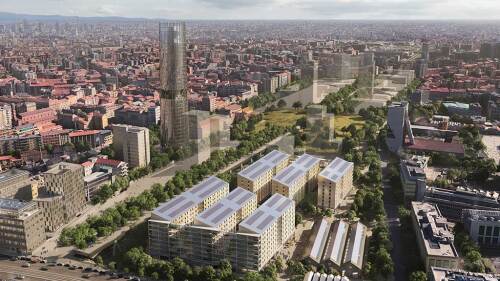No one tool can solve a problem as seemingly intractable as the lack of affordable housing in the U.S., but many cities recognize that zoning reform can be a valuable catalyst to increase all types of housing supply.
“The silver lining is that the affordable housing crisis is so severe that this is one of the top issues facing constituents, so politicians are more likely to address it,” says M. Nolan Gray, a Los Angeles–based city planner and the author of Arbitrary Lines: How Zoning Broke the American City and How to Fix It. “For example, dozens of cities scrapped their exclusionary single-family home zoning and parking requirements in the past few years, which was previously inconceivable.”
Cities that face a significant affordable housing challenge are becoming more open to making zoning changes, says David Garcia, policy director for the Terner Center for Housing Innovation at University of California, Berkeley.
“Many jurisdictions are reluctant to use zoning reform to increase housing because there’s nearly always a backlash to changes,” Garcia says. “But the idea of allowing multiple units to be built on what were single-family home parcels is getting a lot of attention.”
In many cities, zoning changes are relatively recent, which means their impact is just beginning to bear fruit, Garcia says. In addition, many zoning changes are too limited to have the intended impact, but wide-ranging zoning can be particularly difficult to enact.
“Zoning created the affordable housing crisis by being laser-focused on low-density, auto-centric, single-family houses,” says Toccarra Nicole Thomas, director of land use and development at Smart Growth America, a nonprofit based in Washington, D.C. “Zoning is inherently designed to be inflexible.”
Piecemeal zoning reform can be easier to achieve but will probably be less effective to address the affordable housing shortage.
“Some jurisdictions play around with zoning by allowing ADUs [accessory dwelling units] or upzoning so you can put several units on one property, or allowing ‘missing middle’ housing that looks like a single-family home but has multiple units,” Thomas says. “But to be effective to preserve or generate affordable housing, zoning must be reformed in a comprehensive way.”
Still, there’s not a lone comprehensive zoning plan that would work for every city. In Boston, for example, sections of the inner suburbs require homes to be built on two-acre (0.8 ha) lots, says Jenny Schuetz, a senior fellow at the Brookings Institution in Washington, D.C., and author of Fixer Upper: How to Repair America’s Broken Housing Systems.
“Communities like that could use zoning reform to allow rowhouses to be built,” Schuetz says. “But in Washington, D.C., you have neighborhoods with plenty of rowhouses that could benefit from zoning that allows three- to six-story apartments.”
Mandatory inclusionary zoning in New York City, Washington, D.C. and San Francisco, which typically requires that 8 percent to 20 percent or more of units in new buildings be set aside as affordable to households with various income levels, has made limited progress toward reducing the housing shortage.
“Less than a thousand units of housing were built in New York City, a city of eight million people, in 2022,” says Adam Leitman Bailey, founder of Adam Leitman Bailey P.C., a New York City real estate law firm. “All new construction in New York City is supposed to have a minimum of 20 percent of the units reserved for affordable housing, but when so little housing is being built, that doesn’t make a dent in the need.”
Zoning reform options
Zoning codes raise housing costs by blocking new housing from being built, requiring lower density, mandating higher quality housing through minimum lot sizes and other design restrictions, and adding a review layer to permitting, Gray says. Although options to address those issues are abundant, both political considerations and location-specific factors are likely to influence which zoning reforms will be the most effective.
“The number one zoning reform that would help is to allow building ‘by right’ for every house—in other words, builders and developers can just get a permit at the county office and start building, instead of having a discretionary review and public comment for every project,” Thomas says. “But every zoning code update should include at least three changes, such as reducing lot size requirements, eliminating parking restrictions, and allowing manufactured housing.”
Zoning reform approaches that many cities and communities can adopt include:
Commercial corridor focus. One of the most high-impact zoning reforms is to allow multifamily buildings in underused commercial corridors, Gray says. In Oakland, California, for example, Auto Row, which was a languishing neighborhood with several blocks of auto shops, added about 1,000 housing units through comprehensive planning, Garcia says.
Revitalizing commercial corridors can net a big win because infrastructure is already in place, Thomas says.
Expand property options for single-family lots. Single-family detached homes with yards are the most expensive homes to build, especially in big cities with high land costs, Schuetz says.
“In D.C., there are neighborhoods, like Kalorama, a mile from downtown ... built out at capacity with single-family homes,” Schuetz says. “The Westside of Los Angeles has smaller homes, built after World War II, but they’re also one house per lot. In New York City, there are low-density neighborhoods in Brooklyn, Queens, and Staten Island.”
The solution is to expand the uses of single-family lots to allow duplexes, townhouses, several detached houses, or multifamily buildings on these lots, as many cities are doing, she says.
- Rezone to encourage missing middle housing. “Missing middle” housing refers to various of housing options, such as townhouses, duplexes, and small apartment buildings, that fill the gap between single-family homes and high-rise apartments. Missing middle housing allows greater density without changing the character of a community, Thomas says.
- Repurpose underused land. Land around schools and churches, as well as former industrial spaces in cities, can be rezoned to include residential components. In D.C., for example, former industrial areas such as the Navy Yard and NoMa were rezoned to allow mixed uses including residential buildings, which has resulted in dozens of high-rise apartments and condos in those areas, Schuetz says.
- Reduce parking minimums. Reducing or removing parking minimums can cut developer costs, add density, and allow for alternate uses of land instead of surface parking. “There’s no such thing as ‘free’ parking,” Gray says. “Providing parking adds to the cost per unit.”
- Revise height restrictions. A simple way to increase density and the supply of housing is for cities to allow taller multifamily buildings, particularly in central city locations.
- Eliminate barriers to ADUs. Allowing ADUs “by right” can encourage property owners to build them, although this option puts the responsibility to create more housing on homeowners, Thomas says. Whereas some ADUs are used as extra living space, thousands have been built that may add to the supply of affordable housing.
- Create opportunities for office-to-housing conversions. Given rising office vacancy rates, cities should set the table to accelerate office conversions by eliminating zoning barriers to residential use, Garcia says.
- Streamline the permitting process. Significant progress can be made by making the permit process more predictable and financially feasible, Gray says. “Discretionary reviews in Boston and other cities, along with environmental reviews in California, add cost and delays to projects, especially affordable housing projects,” Gray says. In November 2023, Los Angeles Mayor Karen Bass directed several departments to reduce discretionary review of projects and cut the time required for mixed-use permits.
- Establish simple design standards. Many cities don’t think enough about setting straightforward design standards, Garcia says, which can be especially valuable in neighborhoods where opposition to zoning reform is anticipated.
“It’s fair for people to be concerned about what their community will look like, so creating reasonable minimum standards could make neighbors more welcoming,” Garcia says.
The politics of zoning
A risk of attempting zoning reform is that, done poorly, it can cause people to lose faith in the process, Gray says.
“People will say, ‘We tried that, and it didn’t work,’ if you reform the code and it doesn’t increase the supply of housing,” he says.
To address the affordable housing crisis, both zoning reform and subsidies are required, Gray says.
“As long as it’s illegal to build townhouses, apartments, and homes on small lots, subsidies, LIHTCs, and vouchers won’t make a difference,” Gray says. “If you do zoning reform, then you need to take the next steps and figure out what kind of support is needed to create housing for the most vulnerable people.”
Whether zoning decision makers are elected or appointed, zoning reform frequently becomes political, Thomas says.
“Anytime you introduce change, it brings out the NIMBYs and the BANANAs [Building Absolutely Nothing Anywhere Near Anything],” she says.
The hearing process structure makes it difficult for people with multiple jobs, single mothers, and parents of young children to attend, Gray says. City leaders should make an effort to have every community member heard.
“Maybe the person who shows up every week to yell isn’t representative of that community,” Gray says. “Developers can build a bipartisan coalition around zoning reform, which includes a variety of stakeholders, such as home builders, AARP, equity groups, the local chamber of commerce, and real estate agents.”
Garcia recommends that developers have conversations with people in the communities where they hope to build well before a project is up for discussion.
“Developers need to do work on the front end to avoid a fight and to have the data to show that new housing can increase the value of existing homes,” he says.
If city leaders recognize that both younger people and older people value walkable mixed-use communities more than they value single-family homes, that could make zoning reform politically easier, Thomas says.
In some cities, zoning reform is too limited, whereas in others the process can stop development.
“A big part of the problem in New York City is that while the law says 20 percent of all new developments must be affordable housing, when my clients try to get permits, they’re told a development has to be 51 percent affordable housing,” Bailey says. “If you overreach and push developers too far, they just walk away from the deal because it’s impossible to make money unless you get a tax abatement.”
Despite D.C.’s success with encouraging more housing to be built in places such as NoMa and the Navy Yard, the city hasn’t touched zoning reform in most areas, especially in neighborhoods with large single-family homes, Schuetz says.
“In Los Angeles, zoning reform is concentrated downtown, around transit stations and in areas that were former surface parking lots,” Schuetz says. “But the political bargain is that zoning changes haven’t affected West L.A. It’s the same thing in Boston, where the big developments are in lower-to-middle income neighborhoods in East Boston.”
Developer role in zoning reform
Cities that bring developers into the reform process are more likely to see substantial progress on increasing the supply of affordable housing, Garcia says.
“In some cities, simply allowing housing other than single-family homes doesn’t necessarily change what’s built,” Garcia says. “Cities need to ask what architects and developers need and work backwards from there to make comprehensive reform. If you don’t change the rules about setbacks or design elements, it’s a missed opportunity.”
Developers first need to be good corporate citizens and get to know community leaders, city leaders, and planners to build trust before contentious conversations begin, Thomas says.
“They can be advocates for a community benefit agreement in a place that’s not ready for a full-blown zoning overhaul,” she says. “Maybe they can just request a relaxation of building heights or demonstrate the need for two-, three-, and four-bedroom apartments in a community where they’re not built anymore. They can offer to build a park in exchange for things like shared parking instead of a garage for every unit.”
Zoning reform is essential for any community to thrive, Thomas says.
“Zoning reform is a process,” Gray says. “We’re rolling back 100 years of policy that made it nearly impossible to build housing in dense cities, so it will take time to fix .... But I see progress happening everywhere, and anything is possible over the next several years.”
For more information on zoning reform, you can check out ULI’s Reshaping the City: Zoning for a More Equitable, Resilient, and Sustainable Future on Knowledge Finder. The report was also discussed on a webinar which you can listen to on demand, including Nolan Gray and Tocarra Nicole Thomas from this article.










